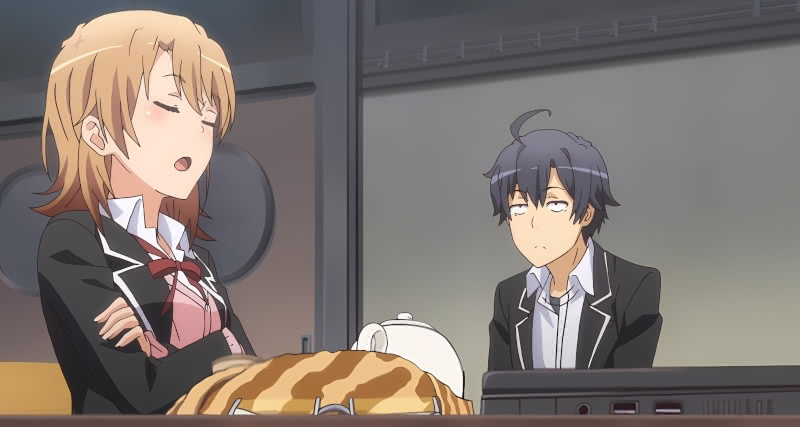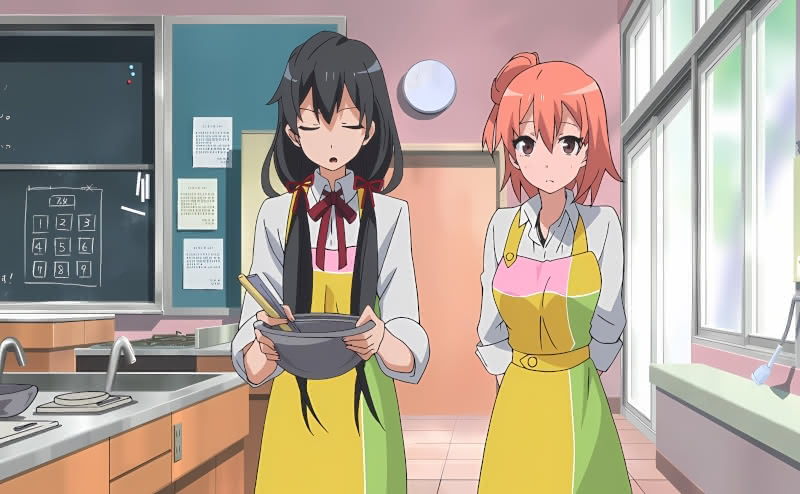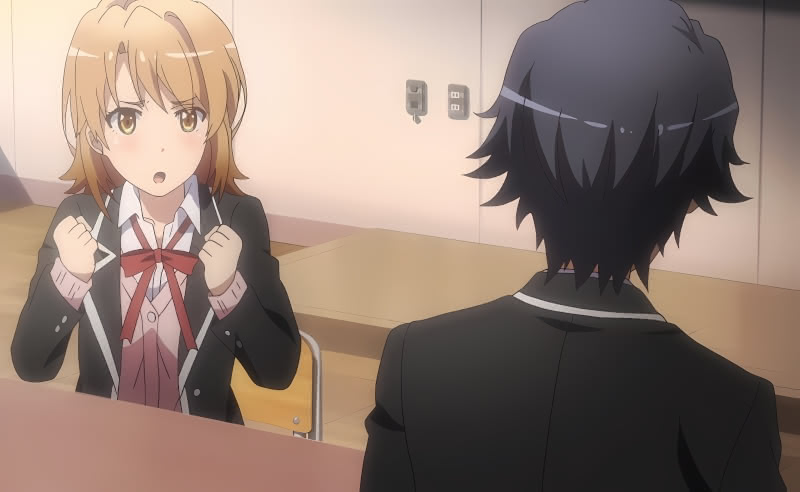I previously published an article about hair color controversies in Japanese schools. In a moment of levity at the start of that article, I wrote that, “[c]ontrary to the impression one might get from watching anime and consuming other forms of Japanese media, the overwhelming majority of Japanese people have naturally non-black hair.” In that passage, I linked to a SoraNews24 article posing an interesting question: Do anime (Japanese cartoons) viewers think that characters with blue, pink, or green hair actually have those hair colors, or do they think that creative hair colorization is merely artistic license? In this article, I will discuss the case of an Japanese (as in she is Japanese) anime character who we are told has nautrally brown hair: My Teen Romantic Comedy SNAFU’s (Oregairu’s) Iroha Isshiki.
(See my full collection of posts on hair color in Japanese anime, manga, novels, and games.)

Having seen the anime before reading the novels, I had assumed based on the context of the series that Iroha dyed her hair. It was only around the time I wrote about a real story of brown hair-struggles in Japan that I learned from one of the Oregairu novels that Iroha’s hair is actually brown.
(Update for January 11, 2022: I fixed two typos in the introduction to this article. I replaced the original three images with upscaled versions. Since publishing this article, I have written a number of other posts on hair color in Japanese anime, novels, and games [see series] One of these articles focuses on another Oregairu character who is portrayed as having brown hair in the anime, but actually has black hair according to the novels. I recommend reading after working through the Iroha post.)
How should we interpret anime hair colors?
On January 7, 2020, SoraNews24 published an article by Casey Baseel titled “Do Japanese people think all those anime characters REALLY have blue, pink, and green hair?” SoraNews24 listed it as a related article to one of the real school hair stories I used for my more serious piece.
I never thought much about strange hair colors in anime except when it is specifically noted. To the extent that I ever thought about it, I generally assume that – in non-fantasy shows – strange hair colors are artistic license. For example, let us take the case of Toradora!, a popular anime and lite novel series from the late 2000s. The show is set in a modern high school. There are no supernatural elements in Toradora!; it is a straight romantic comedy with some occasionally unfortunate melodramatic excesses. In this picture, you will see that four of the five main characters had blue, green, and magenta hair. Did I watch Toradora! thinking that these ordinary high school students had such unusual hair colors? Not at all – I assumed it was for artistic license.
In some fantasy anime or shows that otherwise have supernatural elements, the question may be more muddled. Perhaps in shows with elves and ogres, characters depicted with blue and pink hair actually have blue and pink hair. I usually avoid those shows anyway. But I digress. This is a good segue into Mr. Baseel’s article proper.
A question from the creator of Sword Art Online
Mr. Baseel’s article was prompted by a question posted by Reki Kawahara, the creator of Sword Art Online, a popular lite novel and anime series wherein the main characters are trapped in the world of an online video game. (I did not include Sword Art Online in my list of anime recommendations from 2011-2020 because I did not like it, but that is neither here nor there.)
Mr. Kawahara wondered aloud on Twitter, that terrible platform, how anime viewers interpret strange hair colors. He stated that he had ordinarily assumed that strange hair colors were “a form of artistic expression.” However, his comfortable worldview was shaken when a character in an unnamed manga (Japanese comic) referred to another as “the girl with pink hair.” Mr. Baseel translated Mr. Kawahara’s Twittering on the matter: “If she has naturally pink hair, then she’s living in a parallel universe, and if she’s dying her hair pink, she’s got a punk-rocker thing going on.”
Mr. Kawahara posted a question to Twitter. He narrowed it down a bit, asking people to offer their thoughts on anime characters with unnatural hair colors in anime that are set in modern Japan. That is, he excluded shows with fantasy settings. 22,277 Twitterers responded to the poll, which was written in Japanese. Below, I will reprint the results of the poll, as reported and translated by Mr. Baseel.
- 64.6% – The character’s hair is naturally that color
- 6.9% – The characters dyed their hair that color
- 25.7% – The characters have hair that’s actually black or brown, but shown as pink, etc. for artistic purposes
- 3% – Other
I suppose that Mr. Kawahara and I are in the minority, at least in the universe of Japanese anime viewers. What of the respondents who answered “other”? Mr. Baseel reported that “one commenter said that for him, ‘it depends on the character in question. If a quiet, reserved girl has pink hair, I take that as her natural color, but if it’s a more energetic and extroverted character, then I think there’s a chance she dyed it.”
(Well, that is certainly a take.)
Mr. Baseel concluded his article by opining that there may not be a single industry-wide answer. In most cases that is true, but in some cases, the content does address the issue.
Hair Colors in My Teen Romantic Comedy SNAFU!
In my article on real hair color stories from Japanese middle and high schools, I addressed the case of a student who was harassed by her teachers on account of her naturally brown hair until she was expelled. As we learned there, while it is uncommon, some Japanese people do have naturally non-black hair. Fortunately, not every case turns into the kind of train-wreck as did that story from Osaka.
My Teen Romantic Comedy SNAFU!, which I addressed in two prior essays and in my anime recommendations post, is set in a real-world modern high school in Chiba Prefecture. There are no supernatural elements in the show. It is entirely a drama and occasional romantic comedy. The show itself is based on an underlying series of lite novels, My Youth Romantic Comedy Is Wrong, As I Expected, which I am reading now. Although the anime closely tracks the novels, the novels contain more content than does the anime, due to the fact that the anime series was forced to condense more than 3,000 pages into 38 20-something minute episodes.
The anime depicts characters with black, blonde, and brown hair, with one case of gray hair and another case of blueish-brown hair. The context of the show suggests that some of the characters may actually be dying their hair, whereas others (see the gray case, for example) are examples of artistic license. I never thought too hard about it, but the novels give readers greater access into the thoughts of the protagonist, Hachiman Hikigaya, who had some thoughts on hair color.
Hair color descriptions in My Youth Romantic Comedy Is Wrong, As I Expected
Well before the heroine of this article, Iroha Isshiki, made her appearance in the series, the main protagonist, Hachiman Hikigaya, set a precedent for how we should interpret character hair colors.

In the very first volume of the novels, Hachiman met Yui Yuigahama, who would prove to be one of the series’ three main characters. Hachiman describes her hair as “chestnut-brown.” Thus, we know for a fact that her hair was, in fact, chestnut-brown. But was that her natural hair color? Hachiman thought not. In a series of internal put-downs, he grouped Yui with “fashionable teenage girls” who had their “tawny hair bleached bright.” In context, his view is that Yui was dying her hair. Furthermore, this passage sets the precedent that hair-dying was not uncommon among students at his school.
We can contrast Hachiman’s derisive description of Yui with his description of Yukino Yukinoshita. There, he described her “flowing black hair” upon meeting her in the first volume. That would be a trend – he monologues at least one overly-detailed description of Yukino’s hair in every volume.
Regarding Saki Kawasaki, a secondary character who is depicted in illustrations as having blue hair, Hachiman described her in volume 7.5 as having “blue-tinged black hair.” While that is an unusual description, the series established a precedent from the onset that Hachiman provides serious hair-color assessments. With the introduction done, we can examine the cause of Iroha Isshiki and her apparently naturally brown hair.
Iroha Isshiki’s Is Brown(?), as I Expected(?)
Iroha Isshiki, who is depicted with brown hair, plays no role in the first half of the anime and novels, but she ascends to the status of a main character in the second half. Although she made a cameo appearance in volume 7.5 of the novels, she first entered the scene in earnest in volume 8. Upon her entrance into Hachiman’s club room, he provided the following description of her hair in an internal monologue:
[H]er shoulder-length light-brown hair swayed. It seemed that was her natural color—perhaps the flecks of sunlight dancing across it were due to her cuticles.
Hachiman Hikigaya describing Iroha Isshiki’s hair in volume 8 of My Youth Romantic Comedy Is Wrong, As I Expected (emphasis added)

I had assumed without ever thinking much about it that Iroha dyed her hair brown, much like many of the other characters in the show appear to. Nothing about the image-conscious Iroha dying her hair brown would be out of character I was mildly surprised to learn in the novel, more than five years after seeing Iroha’s introduction in the anime, to discover that her hair is naturally brown. Furthermore, there is no indication in the show or in the novels that I have read thus far that Iroha has a foreign parent. Thus, she seems to be one of those somewhat rare cases of a Japanese person with naturally non-black hair.
Iroha Isshiki Brown Hair Take-Aways
Hachiman prides himself on being observant of the manner and appearance of those around him, considering it a trait of being anti-social. His noting Iroha’s apparently natural brown hair in his internal monologue was no surprise. I am curious, however, why the author of the novels, Wataru Watari, decided to give Iroha naturally brown hair and make a point of noting it. Perhaps she was based on a student from his own school days – which he stated he only closed the book on by finishing his novel series.
I reached the passage about Iroha’s brown hair a few days before writing my article about the unfortunate real case of the brown-haired girl in Osaka. I had not at first thought to make an article of it, but after writing an entire article about Japanese students with naturally non-black hair, I went back and examined the hair color descriptions in My Youth Romantic Comedy Is Wrong, As I Expected a bit more closely. In the end, I suppose that Iroha’s Isshiki’s hair was browner than I had expected.
(See my proverbial follow-up on the hair color of a minor character from the series, Kaori Orimoto.)